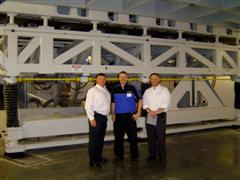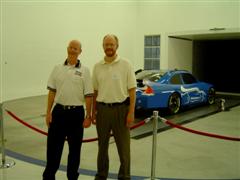A four thousand, five hundred and fifty pound (4550 lbs.) race car is running at 170 mph and facing wind resistance of 150 mph. The car then enters a curve creating a three-degree “yaw” (the change in angle from the direction the car is headed and the airstream). The car struggles to maintain speed as the yaw changes and the dynamic downforce load on the car changes. Suddenly, the driver-less car comes to a stop on the stainless-steel track. The rolling-road track is supported by a cushion of compressed air. The lights dim in the test facility and some engineers review the data on their computers. The test is over and the race team engineers have collected the performance data they needed on their race car. Sensitive compressed air pressure sensors (accurate to ±¼ lb.) have played a key role in measuring the performance of the race car. This is the type of race car testing going on at Windshear Inc, in Concord, North Carolina.
| The Windshear Single-Belt, 180 mph, Rolling-Road in Concord, North Carolina. |
Demand for Data
Windshear Inc. held the formal opening, in July 2008, of North America’s first commercially available, single-belt, 180 mph rolling-road wind tunnel facility in Concord, North Carolina. Windshear Business Unit Manager Peter Zierhut said, “Our facility offers highly accurate, repeatable test data previously only available to a select few Formula 1 teams, and never before available anywhere in North America.”
Windshear Inc, is an independently operated division of California-based Haas Automation. Jacobs Technologies (a division of Jacobs Engineering) staffs and operates the facility. Jacobs Technology specializes in design, construction, and operation of wind tunnels for automotive and aerospace industries. In addition, when race teams bring their cars in for testing, they want to know that their performance data will remain confidential. “Security protocals developed by “Jacobs Technologies guarantees the security of the data for our clients”, said Zierhut.
| Left to Right: Carl Kline (Haas CNC Racing) and Jim Bruce (Atlas Copco) with the on-site oil-free rotary screw compressors at Windshear Inc. |
Race teams are always looking for that extra edge which can mean the difference between victory and defeat. Demand for renting time at the testing facility is reported to be strong with 2008 having been booked for the rest of the year. Demand for 2009 is said to be strong with dozens of customers involved from top-level motorsports companies organizations in F1, NASCAR, and IndyCar as well as and auto manufacturers.
| Left to Right: Carl Kline (Haas CNC Racing) and Jim Bruce (Atlas Copco) with the on-site oil-free rotary screw compressors at Windshear Inc. |
Compressed Air supports the Rolling-Road
The Windshear rolling-road is manufactured by MTS Systems. The Single Belt FlatTrac® Rolling Road is elevated dozens of feet off the ground. The stainless steel track is 10.5 feet wide by 29.5 feet long and 1 mm thick. The track “sits” upon a cushion of 150 psi compressed air. A key piece of technology is in the “revolutionary through-the-belt” sensing system, which directly measures the aerodynamic downforce produced by the vehicle.
A series of air bearings keep the track “rotating” on the cushion of compressed air. Nozzles within the air bearings are also able to create an 8 degree angle which simulates the conditions when taking a turn on the racetrack. Downforce is provided by the wind tunnel blowing air on the car. The fan is twenty two (22) feet in diameter and is powered by a 5,1300 horsepower motor. The fan is capable of generating winds of over 155 180 mph.
Extremely sensitive pressure sensors (tolerance of ¼ lb.) are able to measure and record how muchthe amount of downforce is on the car. The static downforce is created by the weight of the car and the dynamic downforce is created by the resistance of the wind on the different parts of the car. The pressure sensors can measure this “drag” on all parts of thein various track configurations andto see how well the car is will performing.
“Windshear told us they would be testing 4,550 lb. race cars, traveling at 180 mph, into a Hurricane Category 4 headwind, and that they wanted their pressure sensors to measure pressure to the accuracy of ±¼ lb.” said Jim Bruce, Vice President Eastern Region at Atlas Copco who supplied the compressed air system. “We knew right then and there that we had to use Class Zero oil-free air compressors to protect the sensors.”
 |
||
| Left to Right: Clinton Gentz (Atlas Copco), Brian Nelson (Windshear), and Jim Bruce (Atlas Copco) standing underneath the Rolling Road. |
Selecting the Class Zero Oil-Free Air Compressors
The original specification stated “oil-lubricated compressors could be used if adequate oil removal filtration is provided - including oil vapor removal”. Clinton Gentz, Atlas Copco’s Oil Free Sales Manager based in Charlotte said, “We were able to show Windshear and MTS that the integrity (pressure measurement) of the whole Windshear project would depend upon the proper function and maintenance of several air treatment components – if an oil injected screw compressors was used.”
Windshear agreed to eliminate the potential of any compressor oil contamination arriving on the crucial porous carbon air bearings. “They knew it would be costly and devastating and that ISO 8573.1 Class Zero air compressors were the right solution for their process”, said Gentz.
Oil-Free Rotary Screw vs Oil-Free Centrifugal Air Compressor
After it was agreed that Class Zero air was required, the question became whether or not to use an oil-free rotary screw or a centrifugal air compressor. Carl Cline was tasked with purchasing the compressed air system which would allow the rolling-road to function, “Atlas Copco offers all the product technologies in question (lubricated screw, oil-free screw, and centrifugal compressors). We liked their unbiased product approach in advising us as to what the best system would be for Windshear.” Cline continued, “Our specification calls for 24/7 operation, 365 days a year. We also require that the air compressors provide ±1 psi tolerance of air pressure at the demanded air flow regardless of possible extreme temperature and humidity conditions.” It was also made clear that while the design spec called for full load capability during 8760 hours per year, it was expected to be a application with intermittent demand as the wind tunnel turned on and off during testing procedures.
Dynamic (centrifugal) compressors are greatly affected by ambient and cooling water temperature. The performance of a centrifugal compressor is also diminished when forced to operate above its designed temperature conditions. Therefore, you must design a centrifugal compressor for the hottest expected ambient conditions to ensure adequate flow for the process in the summer months - which is fine until the colder fall and winter months come along. The colder temperatures cause the centrifugal to use more BHP thus creating more air flow which has to be “blown off” or wasted by venting it to atmosphere. The throttling range or partial load performance of a centrifugal compressor is limited to 15-20% of it’s full load capacity so when the demand is below the turndown range the air must be blown off in order to provide a constant delivery pressure.
 |
||
| The selection of air-cooled compressors vs. water-cooled eliminated the potential consumption of 131.4 million gallons of water per year. |
The Solution
The Atlas Copco Z Series is a positive-displacement, oil-free, rotary screw air compressor. The installation is made up of two ZT250 air-cooled machines which provide the base-load air. Fluctuations in demand are taken care of by a ZT315 VSD (Variable Speed Drive) air compressor. With positive displacement compressors, brake horsepower (BHP) will remain nearly constant summer to winter. Yet in the winter, the screw compressor will deliver significantly more mass flow while maintaining BHP nearly constant. In other words, being a positive displacement compressor, the rotary screw compressor’s energy is only slightly effected by changes in air temperature. The Variable Speed Drive (with partial load control down to 30% of full load) matched the required demand and efficiently provides constant pressure delivery within ±1 psig.
 |
||
| Left to Right: Robert and Tom Eshelman (Atlas Copco) supervised the installation and perform the scheduled maintenance on the compressed air system. |
In addition, by offering air cooled air compressors, the installation costs were greatly reduced by not requiring additional cooling water capacity and piping which was very appealing to the Windshear project team and allowed them to size a smaller cooling water system for the overall project. The smaller cooling system provided initial cost savings as well as overall operational cost savings by reducing the required cooling water flow by 250 gallons-per-minute (gpm). The system design specification calls for 8760 hours of operation per year. This equates to 131.4 million gallons of water saved per year – by choosing an air-cooled air compressor. “We were able to save significant installation \$’s by not having to install water cooling systems here at Windshear, “ said Tom Eshelman, Compressor Center Manager for Atlas Copco in Winston-Salem.
Conclusion
Windshear Inc. is open for business and uniquely positioned in the North American market. The compressed air systems are up and running and the rolling-road measurement systems are working perfectly. Race cars are running at 180 mph and engineers are measuring “yaw” and its’ effects on the dynamic downforce on the car. Quietly and efficiently, compressed air continues to play a key role with new technologies and applications.
For more information please email Rod Smith, Compressed Air Best Practices®




